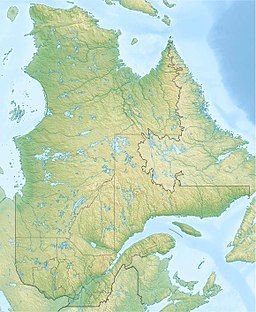
The Ottawa River is a river in the Canadian provinces of Ontario and Quebec. It is named after the Algonquin word 'to trade', as it was the major trade route of Eastern Canada at the time. For most of its length, it defines the border between these two provinces. It is a major tributary of the St. Lawrence River and the longest river in Quebec.

The National Capital Commission is the Crown corporation responsible for development, urban planning, and conservation in Canada's Capital Region, including administering most lands and buildings owned by the Government of Canada in the region.
Harrington Lake is the summer residence and all-season retreat of the prime minister of Canada, and also the name of the land which surrounds it. The farm that surrounded most of the lake was the property of Margaret and John Harrington. John could not farm the land and moved to the local town of Iron Sides. The family stayed on the farm for many years and eventually moved to old Ottawa. The property is located near Meech Lake—where the Meech Lake Accord was negotiated in 1987—approximately 35 kilometres northwest of Ottawa, in Gatineau Park, amidst the Gatineau Hills in Quebec. The property is not open to the public, but the Mackenzie King Estate, the retreat of Prime Minister William Lyon Mackenzie King at Kingsmere, is a tourist attraction located 2 kilometres south in the park.

Lac Beauchamp Park in Gatineau, Quebec, Canada is a large wooded park of 172 hectares built around a small lake in the middle of the suburban sprawl of the eastern part of the city. In the winter it has 15 km of ski and snowshoe trails. The lake also has a skating area. In the summer, the lake has a supervised swimming beach and canoe rentals. The ski trails are then used by amateur naturalists, hikers and bikers.

Gatineau Park is a federal park located in the Outaouais region of Quebec, Canada. Administered by the National Capital Commission as part of the National Capital Region, Gatineau Park is a 361 square kilometres (139 sq mi) wedge of land extending north and west from the city of Gatineau. With a perimeter of 179.2 kilometres (111.3 mi), the park includes parts of the municipalities of Chelsea, Pontiac, La Pêche, and the City of Gatineau. The main entrance to the park is 4 kilometres (2.5 mi) north of downtown Ottawa, Ontario.

Thomas Leopold "Carbide" Willson was a Canadian inventor.

Pink Lake is a meromictic lake located in Gatineau Park, Quebec, Canada. The surface of the waters are a deep green during the month of August and September due to the abundance of algae in the water. The lake is in danger of eutrophication due to human activities. Park management forbids swimming in the lake, walking domestic animals near it, straying from the wooden boardwalk for sight-seers, and throwing stones into the lake.
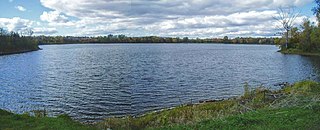
Leamy Lake is a lake in the Hull sector of Gatineau, Quebec, Canada. The lake is located just to the south of the Gatineau River, and just west of the Ottawa River, and is linked to both of them with flowing in from the Gatineau and exiting to the Ottawa. To the south is the Lac de la Carrière, a former quarry that is now a lake that is also linked.

The Rapibus is a bus rapid transit system for the Société de Transport de l'Outaouais (STO) in the city of Gatineau, Quebec. Construction was completed in the summer of 2013 with service beginning in the fall. The Rapibus aims to speed up the service for commuters in growing sub-divisions in the northern and eastern areas of the city by alleviating the congestion on key arteries currently served by bus-designated lanes. A direct link to Ottawa is included.
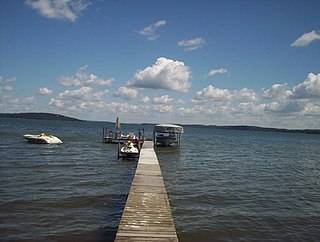
Green Lake — also known as Big Green Lake — is a lake in Green Lake County, Wisconsin, United States. Green Lake has a maximum depth of 237 ft (72 m), making it the deepest natural inland lake in Wisconsin and the second largest by volume. The lake covers 29.72 km2 and has an average depth of 30.48 m (100.0 ft). Green Lake has 43.94 km (27.30 mi) of diverse shoreline, ranging from sandstone bluffs to marshes.
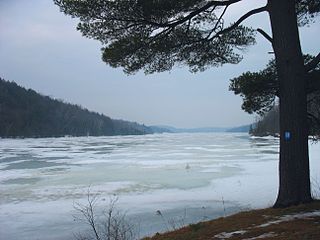
Lac Philippe is a medium-sized lake located on the north side of Gatineau Park. The lake is one of a chain of freshwater lakes found within the Gatineau park that drain into the Gatineau River through Meech Creek. It is one of the largest bodies of water in the northernmost stretches of the park, along with lac La Pêche and lac des Loups, which are located in the extreme northwestern reaches. The lake is approximately a 45-minute drive from Ottawa

Blue Sea Lake is a lake in the municipalities of Blue Sea and Messines, Quebec, Canada, about 90 kilometers (56 mi) north of Gatineau. It is known for its crystal clear water and is surrounded by cottages on its shores.
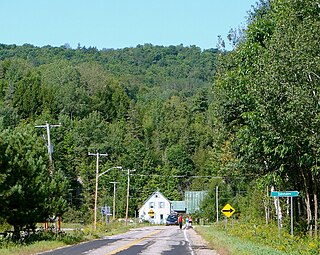
Denholm is a municipality in La Vallée-de-la-Gatineau Regional County Municipality, Quebec, Canada, 40 kilometres (25 mi) north of Gatineau. Its territory is along the eastern shores of Lake Sainte Marie, part of the Gatineau River.

Lake Winnipeg has experienced excessive algae blooms since the 1990s. The lake's toxic blue-green algae has led to a deterioration of water quality, posing hazards to both human and animal ecosystems. The blooms are caused by high concentrations of nitrogen and phosphorus from fertilizer runoff and sewage draining into the lake via rivers and surface runoff.

The Capital Pathway, also known informally as the Bike Path, is a 220-kilometre (140 mi) recreational pathway interlinking many parks, waterways and sites in Ottawa, Ontario and Gatineau, Quebec. Most of the pathway is paved, and allows an almost continuous route through the National Capital Region.

Victoria Island is an island in the Ottawa River, located north of LeBreton Flats, 1 km west of Parliament Hill in Ottawa, Ontario. The island is "a place of special significance" to the local Algonquian peoples, who use the island for ceremonial purposes and for protests. It is part of an archipelago of islands below Chaudière Falls, which also includes the former Philemon Island, Chaudière Island, Amelia Island and Albert Island.
Petit Lac Saint-François or Lake Tomcod is a lake in the municipality of Saint-François-Xavier-de-Brompton, in regional county municipality (MRC) of Le Val-Saint-François, in the administrative region of Estrie, Quebec, Canada. Cyanobacteria are present in the lake.

Lake Saint-Charles is a lake located in the Capitale-Nationale region of Quebec, Canada. It is located partially within the Quebec City borough of La Haute-Saint-Charles and partially within the united township municipality of Stoneham-et-Tewkesbury.
Carheil Lake is a lake in the Côte-Nord region of Quebec, Canada. It is just south of Fermont, and is the source of the Carheil River, which runs south to the Aux Pékans River. The lake has been polluted with phosphorus from wastewater effluent from Fermont, causing algal bloom. This is cause for concern since the lake is among the headwaters for the wild and unspoiled Moisie River.

LakeStukely is a 4 square kilometres (1.5 sq mi) natural lake located in the Eastern region of Quebec, Canada. Its waters border the municipalities of Orford, Bonsecours, Eastman and a large part of Mount Orford National Park. It lies at the head of the Saumon River watershed, giving it a fairly long retention time for its size.


